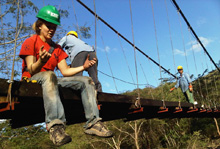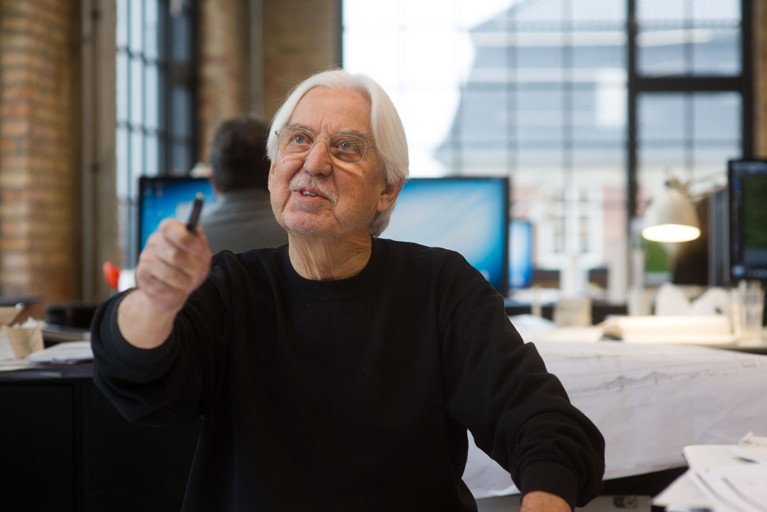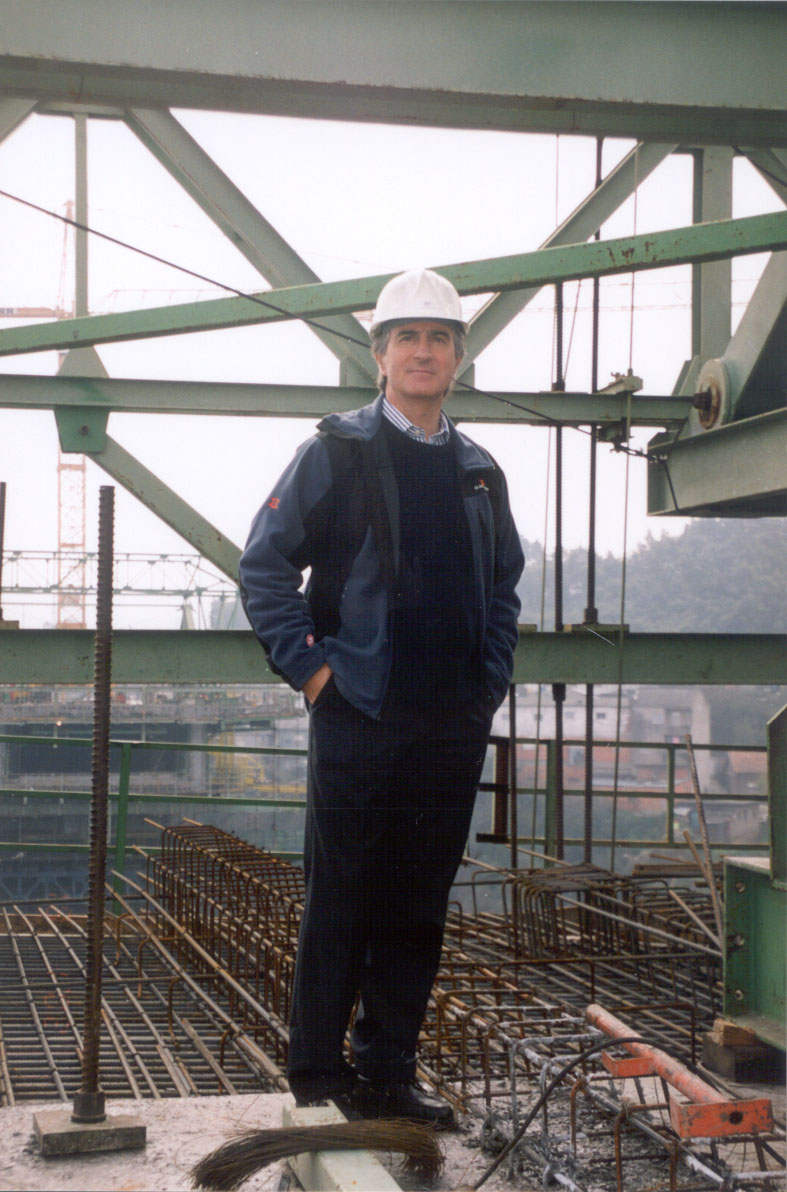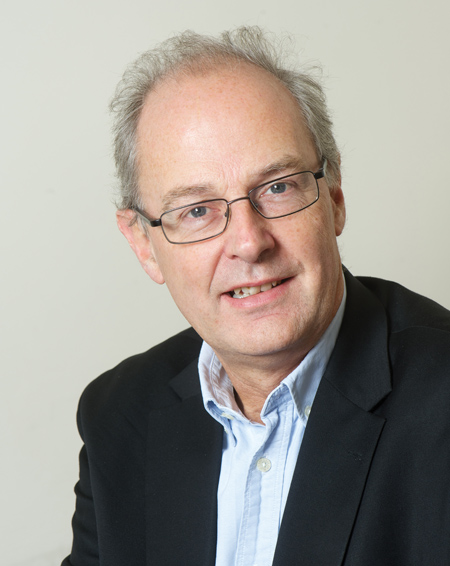
Considering his high profile in the international bridge industry and his regular involvement in major conferences, it’s somewhat surprising to learn that Cowi UK director Ian Firth is still capable of suffering from nerves. Catching up with him just a few days after his inaugural presidential address in late January, he admits to having been rather nervous ahead of the event.
It might well be due to the industry-wide authority that the position commands, and the fact that during his tenure he is keen to push strong messages that the profession needs to do better. Firth has firm opinions, particularly on bridge design quality, aesthetics, and procurement, and he is not backward in coming forward with them.
The importance of design quality is one of the central messages he wants to get across during his time as president of the Institution of Structural Engineers. “Bridges are dominant features in the built environment, and it’s so important that we get the design right,” he says. “There is no excuse for mediocrity or crass ugliness. Good enough is not good enough,” he says. “It’s very tempting to size up a beam or structural component and then stop there. We need to go a stage further; with a bit more work we can make something so much better.”
As design and build contracts become more widely adopted by clients in the bridge industry, Firth is keen to raise a flag about the issue of design quality and the challenge of maintaining it through this type of procurement process. While not much of his work is directly in D&B, he is still keenly aware of the potential pitfalls and challenges that it creates for designers.
“A lot of my work is in conceptual design – either in design competitions or through commissions – but sometimes these ultimately get delivered as D&B contracts, where there is a big difference in emphasis,” he says. Once the bidding has been completed and the client is happy with the price, as far as the contractor is concerned it’s all about delivery. The designer’s vision, along with the details that make the bridge special, is often at risk of being lost in cost-saving changes.
“I’m very happy to work together with contractors – as long as the emphasis is on ‘together’ and we have the opportunity to intervene at the right moment as necessary,” he says. “Not all cost-saving changes are bad, let’s be honest, and some are even an improvement. But sometimes the finesse can be lost due to practical expediency and this is a real shame.”
If designers find themselves in this kind of situation the only answer is to be strong and persuasive enough to make the contractor realise that these things matter, he adds. Savvy clients will emphasise the importance of quality in the contract – in some major projects such as the Queensferry Crossing and Mersey Gateway in the UK this is enshrined in the reference design – and might also look for signs that the contractor is committed to delivering a quality project when they are assessing the bids.
Design quality is crucially important on smaller bridges, especially when there is a cyclist or pedestrian element on the structure, meaning it is experienced at slower speeds and closer quarters. “The quality of the details really matter in this case,” Firth says, “and any loss of quality on such structures will be easily noticed.”
More worrying is a trend that he is now seeing in the bridge industry – and one he highlighted in his inaugural address – of the blurring of lines of responsibility on site, as well as the increased risks that come with changes in working methods.
Safety on site is being eroded as a result of the designer’s role being downgraded, Firth believes, and he is very much afraid that it is only a matter of time before we see another ‘ghastly disaster’ along the lines of the box girder collapses of the 1970s. The significance of these collapses, which were fresh in the minds of Firth and his contemporaries at the start of his professional career, seem to be losing their impact over time. “These collapses taught us that we need to have a detailed understanding of the responsibilities of the different parties involved in a project, and that we should pay attention to the lines of communication between them.”
Two fundamental recommendations that came out of these events were the importance of designs being independently checked, and the value of the designer being on site during construction to monitor construction. Both of these are being ignored in certain circles, Firth says, for example when projects are not funded with public money, and hence an independent check is not mandatory, and by some contractors delivering design-build contracts.
Not only is safety being put at risk by this shortsightedness, but also quality – and hence durability, he says, which is also a very important risk criteria. “The professionals who need to do stuff are not being appointed with sufficient freedom to do it,” he says. “They need to be given the money to do it, the time to do it and the authority to do it. They are not getting that because people just want to cut corners.
“I find it incredibly short-sighted that clients are not prepared to spend just another half a percent of the cost of the project to have an independent check carried out. This would give everyone the confidence that the risks were being properly managed,” he says. And while an independent check might be mandatory on publicly-funded projects, in his experience site supervision may still not happen. Designers might be invited to monthly progress meetings but won’t be involved in the day-to-day work on site.
Another trend Firth is strongly resistant to is the constant drive to shorten pre-construction time, which he believes undermines any attempt at innovation. “There is more and more pressure on designers to come up with new ideas – on the one hand clients want innovation, while on the other hand they are squeezing the design time and eliminating any incentive for the designer to innovate. With innovations you have to take the time to identify the risks, to evaluate them and design them out, and to optimise the design. It doesn’t happen overnight. Some people believe that this trend to shorter design times is going to result in nothing more than a catalogue of standard bridges.
“God forbid! It would be the death knell for creativity and design, and the things that make life worth living,” Firth sighs, but just as quickly rallies his spirit. “There is a trend towards it, but it won’t happen because there are people like me kicking up a fuss!”
Firth’s experience and understanding of the design process and the conditions that are needed to nurture it took some time to acquire, with much of his early career focused on structural analysis and complex bridge strengthening work.
He admits to having struggled in his first year of civil engineering at Bristol University. Having studied maths, physics and geography at school he thought that civil engineering would be an appropriate outlet for his creativity; he liked making things, so it seemed like a good idea at the time. “But I’m not sure I really knew what I was letting myself in for at the time,” he now admits.
Despite the initial difficulties he came out of university with a first class degree, a fact which was helpful in promptly attracting a few job offers. Firth’s interest was piqued when he was invited for interview at a small firm that he’d never heard of. Tony Flint had written to the university civil engineering professor Roy Severn because his firm was looking to employ ‘a good graduate’ and Firth had been put forward as a candidate.
“When I went for the interview I immediately knew it was exactly where I wanted to be,” recalls Firth. “It was a small firm but there were pictures of bridges I recognised on the walls. The people interviewing me were inspirational, I thought to myself ‘this is interesting!’” The choice was obviously a perfect fit considering Firth has remained with Flint & Neill since joining in 1979 – working his way up from graduate engineer, becoming a partner in 1990 and chief operating officer in 2008 when the firm was bought by Cowi.
On joining, Firth recalls that he was thrown in at the deep end right from the start by his new employer. “I immediately got stuck in to some pretty complex engineering problems; it was the end of the 70s, we were getting used to limit state design and the firm was doing quite a lot of work with the new bridge design codes having been involved with the aftermath of the box girder collapses in 1970 and 71,” he says. Tony Flint had been on the Merrison Committee of Inquiry into the collapses, and Firth found himself involved in investigations and developing design codes. “This was not doing design, this was theory. It was a lot of fun. I was doing a variety of work – masts and towers, and research into bridge aerodynamics,” Firth says.
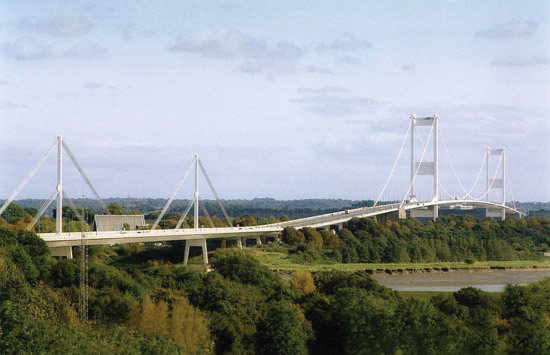
Early experience on the strengthening of the Wye Bridge in the UK enabled Firth to learn a lot about designing for maintenance
After a couple of years’ work he went off to Imperial College in London to do a structural steel design course, which he loved; it served him well in his subsequent role at Flint & Neill on the strengthening of the Severn Bridge. “It was an enormous piece of work,” he explains, “and the work that I was particularly involved in was the Wye Bridge, which is the cable-stayed bridge on the Welsh side of the crossing.” Firth was made team leader for the strengthening of the bridge and connecting viaduct, which he says took him by surprise at the time. “I thought Dr Flint had lost his marbles!” he admits.
“I worked on that project for many, many years, to the extent that I got rather frustrated with it by the end, to be honest. I was ambitious, wanted to make waves; I found myself thinking ‘am I going to be on this job forever?’”
He believes a lot of young engineers go through the same phase, especially when they are working on big projects. “I would say to them ‘stick with it’. You just don’t know sometimes how significant those projects are going to be,” he adds.
The strengthening work led on from a full inspection in 1983 which had found a certain amount of deterioration on this bridge, and identified that it was also carrying much more traffic loading. The towers were extended and a new cable system with additional cables was installed to replace the existing one.

Isometric of the Wye viaduct tower and cable system
“That work was all done with traffic running on the bridge, directly in the public eye; it was an extraordinary time. I learned a huge amount about box girder bridges, I learned a huge amount about how you implement works on site, and it led on to a number of other box girder assessment and strengthening works including Erskine, Milford Haven and Westgate bridges,” he continues.
“I often say that I think for a designer-in-waiting, which is essentially what I was, that kind of strengthening and assessment work is the best experience you can have; to see what goes wrong when you don’t design it right. For example the difficulty of access; so many parts of these bridges were impossible to access that, before you could do any improvement or strengthening work, you had to create access to them. Poor detailing was another issue that it highlighted,” Firth adds.
After a short foray into building design on secondment to a firm of architects, which he found fascinating but which simply underlined his interest in bridges, he was subsequently assigned to the high-profile Hong Kong structures – Tsing Ma, Kap Shui Mun and Ting Kau – for which Flint & Neill was carrying out the independent check. The team also had a significant site presence, especially on Ting Kau. Again, this was fantastically good experience, he says, and yet he was still waiting for that elusive design opportunity.

Ting Kau Bridge - one of a number of major bridges in Hong Kong where Firth was involved in the independent check
Meanwhile back in the UK, the East London River Crossing was in the public spotlight with the proposed bridge over the Thames becoming the focus for objections against its construction as well as debates about the quality of infrastructure design. Two designs – a box girder bridge designed by Halcrow Fox for the Department of Transport, and a bowstring arch designed by Santiago Calatrava for developer Stanhope, which owned the land adjacent to the bridge site – were provoking debate among the engineering fraternity and the public alike. Even the Royal Fine Art Commission weighed in, backing the Calatrava design despite doubts about its buildability. Stanhope came to Flint & Neill for engineering advice and Firth found himself sitting down with Calatrava to assist him in responding to some of the criticisms of his design. It was mainly about developing the construction process, considering the weight of the lift and making it achievable. Initial plans for a concrete deck over the main span were amended in favour of Firth’s suggestion of a steel box girder, but as he suggests, it was rather like trying to justify it after the fact.
Ultimately the whole scheme was abandoned due to environmental objections over the link roads, but as a result of his involvement Firth found himself participating in the Royal Fine Art Commission’s seminar on bridge design in 1992. “It was one of those really interesting moments – the Calatrava bridge was something of a trigger, but there was a general awareness at the time among government and the general public that the quality of the built environment, especially bridges and infrastructure, was rubbish. There was too much crass, ugly infrastructure around and something had to be done,” Firth recalls.
One thing that happened as a result of the seminar was the Poole Harbour Bridge competition in the UK. “The Highways Agency published its guidelines on the appearance of highway bridges in 1994 and there was a political agenda, a general feeling that we needed to do better,” says Firth. The Poole Harbour Bridge competition was launched by the Highways Agency and Firth’s initial suggestion that his employer should take part came up against objections – the other partners felt that there were many other firms which had a better chance of winning. Not only did he persuade them to participate, he also recruited architect Poul Ove Jensen of Dissing & Weitling to the team, having been made aware of his work on Storebælt. The outcome in 1997 was a very high-profile victory which remains a seminal moment for Firth, even though the bridge was never built. “It was something of a watershed for us. Christian Menn was one of the judges of the competition, it was such an extraordinary moment.
“Immediately after that we started doing more bridge design competitions – we were approached by Jim Eyre from Wilkinson Eyre, we entered the Lockmeadow Footbridge competition and won it, we entered a competition for some bridges in Stockholm and won it, we won some other competitions – I can’t remember how many, but that year was a good year! All of a sudden we realised it was not just a flash in the pan.”
He is firmly of the belief that architects are to be welcomed in bridge design. “I regularly hear engineers asking ‘why do you bring architects into bridge design?’ and I can tell them why. Because architects add a dimension, an aspect to bridge design that we otherwise don’t have. Having said that, the engineer needs to keep the architect’s vision constrained within the limits of what’s achievable,” he says.
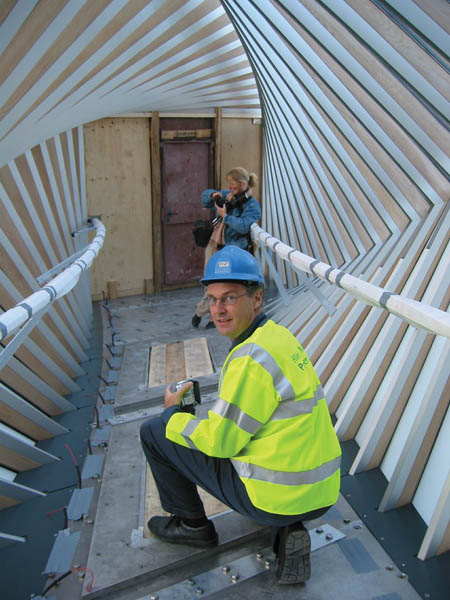
On site at the Bridge of Aspiration
When asked about favourite bridges in his own portfolio, Firth immediately talks about the tiny Bridge of Aspiration which was built for the Royal Ballet School in 2003 in central London. “This is one of my absolute favourites, it’s a small bridge but it’s a delight,” he says. “That was myself and Jim Eyre having an idea on a Sunday morning. Jim had this idea of twisting the bridge – part of the brief was to invoke a sense of movement – and we discussed it over coffee. It ended up being structurally very simple – just a simply-supported beam 9m long – but geometrically incredibly complex,” he recalls.
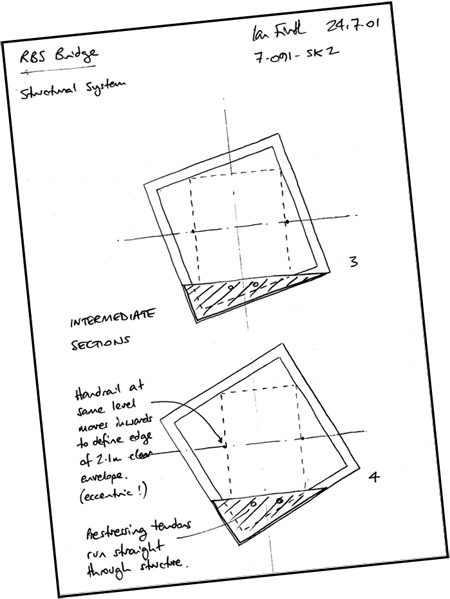
One of Ian Firth's concept sketches for the Bridge of Aspiration
“It was in the early days of use of 3D geometry to define the construction geometry, so very complex. I worked with Martin Knight and Keith Brownlie on this, they were both at Wilkinson Eyre at the time, and I absolutely loved it. “It’s the smallest bridge I’ve designed, but the one I see most often and it’s the one other people know too,” he says.
Firth also mentions Poole Harbour Bridge without hesitation. “Even though it was never built, it was an absolute game-changer and a watershed moment, so it’s significant from that point of view.”
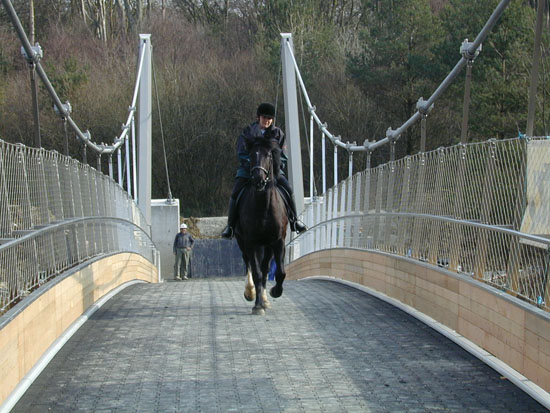
Halgavor Bridge in Bodmin - first publicly-funded GFRP bridge
The 48m-long Halgavor Bridge in Bodmin in the south west of England is a favourite, being the first publicly-funded glass-fibre reinforced polymer bridge. The GFRP structure carries pedestrians and equestrians over a trunk road and hangs from conventional steel suspension cables. Flint & Neill won the project in a Highways Agency bid process that had a high weighting for quality. “The great advantage was that it could be placed overnight, over a busy road,” Firth recalls, “however it turned out to be much more expensive to design than we had anticipated and we lost a fortune. We ended up doing all the testing because we were breaking new ground and there were no codes for what we needed.”
Stonecutters Bridge in Hong Kong has to be ‘way up there’ in terms of favourites, he says. It was a big story; again, Flint & Neill won the high-profile design competition in 2000 along with Dissing & Weitling, Halcrow and Smedi. “We spent a week out in Hong Kong, came back with the idea and won the competition fair and square, which was fantastic,” Firth recalls. But the team did not win the detailed design of the bridge; that went to Arup, although ironically Flint & Neill’s future parent company Cowi designed the main span. “That’s a beautiful bridge and one that I feel proud of, even though I didn’t get to do the detailed design,” he says.
There have been other major bridges – Firth points to Messina being ‘very interesting if it ever gets built’. “Politics and economics are not very stable in Italy at the moment,” he observes, “and until such time as that stability returns, the design will remain on the shelf.” Flint & Neill was acting as adviser to the client and subsequently had to step back from that role when they joined up with Cowi, which was working for the contractor.
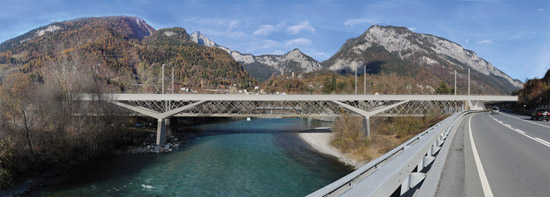
Rendering of the Hinterrhein Bridge in Switzerland (Dissing & Weitling)
Currently his office is working on the Hinterrhein Bridge in Switzerland; another competition-winning entry along with Dissing & Weitling. The bridge is just about to start construction – the contractor has been appointed and they will start on site later this year with completion due 2018.
He highlights a ‘beautiful little thing’ which will also start construction this year; the Taplow Bridge over the River Thames west of London. Firth is working on this with architect Martin Knight, whose interest in the project is particularly strong as he is a local resident. Knight persuaded the client to consider an alternative design which he had developed, and which offered a more sensitive and appropriate response to the location.
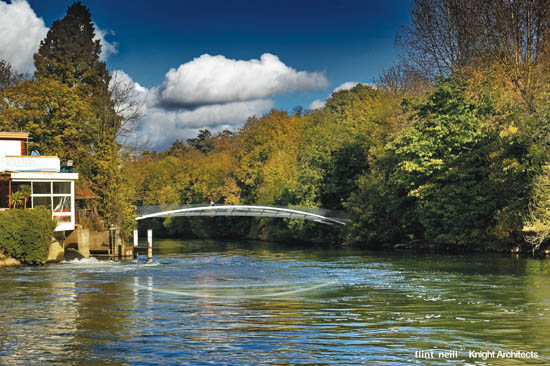
Rendering of the Taplow Bridge over the River Thames, which was carried out with Martin Knight (Knight Architects)
Since Flint & Neill joined forces with Cowi in 2008, the range of bridge projects that the firm now works on is much increased. There are more opportunities for younger staff to travel, and to work with colleagues from around the world, he says, which is good experience and motivation for them. Eight years on from the merger, the Flint & Neill name has just been retired and the Cowi name and branding adopted.
As far as bridges designed by others go, like many of his contemporaries, Firth cites Robert Maillart’s Salginatobel Bridge in Switzerland as a huge inspiration. “It really stands out,” he says. “The location, the concept and everything. Maillart was inspirational in that he was doing new things with concrete in a very quiet and modest way, with great simplicity and lack of fuss. He wasn’t trying to create anything particularly dramatic yet he still managed to do so.”
“Millau Viaduct has to be up there among many others,” Firth says, and reveals that he is a great admirer of French engineer and designer of the bridge, Michel Virlogeux. “Of course the Normandy bridge was the one that first brought him to my attention,” he recalls. “He is a great engineer, and much underrated in some circles, in my opinion.”
Fritz Leonhardt and his colleagues at Leonhardt, Andrä & Partner also have to have a mention, Firth says. “He and his colleagues were doing extraordinary things through the fifties, sixties and seventies with cable-stayed bridges in particular,” he adds. “As a young engineer, I celebrated finishing my masters in 1983 by buying a copy of his classic book Brücken; it remains a regular reference book even now. It was a big purchase at the time, I saved up to buy it,” he recalls.
Jörg Schlaich, a former student of Leonhardt’s and one of the founders of Schlaich Bergermann & Partner is mentioned ‘of course’; Firth believes Schlaich to be ‘one of the greatest engineers of the 20th century’. His son Mike stands out as one of the contemporary engineers who inspires Firth, in particular the work he and his colleagues do in designing ‘really spectacular stuff’ such as lightweight structures, cable roofs and interesting suspended bridges, he says. Another engineer he admires is Christian Menn, and Firth declares himself honoured to have met Menn several times. “He is a great inspiration, he does wonderful stuff,” says Firth.
“Of course I was obviously heavily influenced by my own colleagues in Flint & Neill,” Firth recalls, “including Brian Smith and Tony Flint. It’s something to do with the mindset they had and how they approached problems, with a huge intellectual ability. It was a massive inspiration.”
From the architectural perspective, alongside the regular collaborators he has already mentioned and other influencers such as Cezary Bednarski, he also refers to French architects Yves Pages and Benoît Le Thierry d’Ennequin of Explorations Architecture, and in particular their bridge designs Pont du Neuf in Compiègne and Pont Schuman in Lyon. Firth finds not only that French architects are more used to working with engineers, but that French engineers are more used to participating in design competitions than their UK colleagues.
While he generally supports the use of design competitions for bridge procurement, Firth has been involved in so many that he claims he can tell ‘a mile off’ whether a client’s brief is going to get them what they want. “It can be a great way to secure good design,” he says, “but most clients will only ever do one design competition, and we are doing them all the time.” They need to get it right, he says, otherwise it’s a waste of time for all involved. While some competition organisers can help in making the process more productive, the competitions office at the Royal Institute of British Architects is a problem, he believes, because they tend to promote very low-cost competitions, with fees that are often ‘derisory’, involving a lot of work for a large number of participants with little prospect of winning.
With his passion for good design it is unsurprising that Firth considers there is a crucial element missing in the education of structural engineers. “Why do engineers have a relatively poor profile, compared to that of architects?” he asks. “I think it’s because we don’t consider aesthetics to be our domain, whereas in reality it should be as much our domain as the amount of reinforcement in the concrete!” And when engineers talk about ‘designing’ a beam he cannot help but cringe. “Design is the idea, not the analysis of the structure!” he says. Engineers should be given more encouragement to get involved in peer review of design concepts, to develop their drawing ability, and to discuss ideas with other designers such as architects, he says. An appreciation of aesthetics – and an understanding that they are also entitled to have an opinion about aesthetics – should be as important in their education as all the technical knowledge.
In more recent years Firth has added another bridge-related passion to his portfolio, through his support for charity Bridges to Prosperity which builds footbridges for communities in the developing world. Just recently he has taken this one step further, and set up a UK trust of B2P as a contact point for European firms (Bd&e issue no 85).
This article was published in Bd&e issue no 86, 2017


